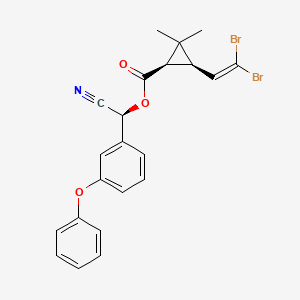D0867 | deltamethrin
P
P03BA03 Decamethrin
[P03BA] Pyrethrines
[P03B] INSECTICIDES AND REPELLENTS
[P03] ECTOPARASITICIDES, INCL. SCABICIDES, INSECTICIDES AND REPELLENTS
[P] Antiparasitic products, insecticides and repellents
| Toxicity | Dose | Time | Species | Model | Method | Action | Positive criterion | Reference |
|---|---|---|---|---|---|---|---|---|
| MEMBRANE POTENTIAL | 45.88±17.92 | human | qHTS-HepG2 | MMP assay | decrease | IC50 | 163 | |
| MEMBRANE POTENTIAL | 50.12 | human | HepG2 | MMP assay | decrease | IC50 | 163 | |
| MEMBRANE POTENTIAL | 39.83±14.21 | rat | hepatocytes | MMP assay | decrease | IC50 | 163 | |
| Pictogram | Signal | Statements | Precautionary Statement Codes |
|---|---|---|---|
  |
Danger |
H301: Toxic if swallowed [Danger Acute toxicity, oral] H331: Toxic if inhaled [Danger Acute toxicity, inhalation] H400: Very toxic to aquatic life [Warning Hazardous to the aquatic environment, acute hazard] H410: Very toxic to aquatic life with long lasting effects [Warning Hazardous to the aquatic environment, long-term hazard] |
P261, P264, P270, P271, P273, P301+P310, P304+P340, P311, P321, P330, P391, P403+P233, P405, and P501; (The corresponding statement to each P-code can be found at the GHS Classification page.) |
  |
Danger |
Aggregated GHS information provided by 369 companies from 12 notifications to the ECHA C&L Inventory. Each notification may be associated with multiple companies. Reported as not meeting GHS hazard criteria by 1 of 369 companies. For more detailed information, please visit ECHA C&L website Of the 11 notification(s) provided by 368 of 369 companies with hazard statement code(s): H301 (98.91%): Toxic if swallowed [Danger Acute toxicity, oral] H331 (100%): Toxic if inhaled [Danger Acute toxicity, inhalation] H400 (99.46%): Very toxic to aquatic life [Warning Hazardous to the aquatic environment, acute hazard] H410 (100%): Very toxic to aquatic life with long lasting effects [Warning Hazardous to the aquatic environment, long-term hazard] Information may vary between notifications depending on impurities, additives, and other factors. The percentage value in parenthesis indicates the notified classification ratio from companies that provide hazard codes. Only hazard codes with percentage values above 10% are shown. |
P261, P264, P270, P271, P273, P301+P310, P304+P340, P311, P321, P330, P391, P403+P233, P405, and P501; (The corresponding statement to each P-code can be found at the GHS Classification page.) |
  |
Danger |
H301: Toxic if swallowed [Danger Acute toxicity, oral] H331: Toxic if inhaled [Danger Acute toxicity, inhalation] H410: Very toxic to aquatic life with long lasting effects [Warning Hazardous to the aquatic environment, long-term hazard] |
P261, P264, P270, P271, P273, P301+P310, P304+P340, P311, P321, P330, P391, P403+P233, P405, and P501; (The corresponding statement to each P-code can be found at the GHS Classification page.) |
| Organism | Test type | Route | Dose (normalized dose) | Effect | Source |
|---|---|---|---|---|---|
| rat | LD50 | oral | 80mg/kg (80mg/kg) | Nature. Vol. 248, Pg. 711, 1974. | |
| mouse | LDLo | intravenous | 6mg/kg (6mg/kg) | Archives of Toxicology. Vol. 45, Pg. 325, 1980. | |
| (1R,3R)-((S)-cyano(3-phenoxyphenyl)methyl) 3-(2,2-dibromovinyl)-2,2-dimethylcyclopropanecarboxylate | (1R,3R)-3-(2,2-Dibromovinyl)-2,2-dimethylcyclopropanecarboxylic Acid (S)-alpha-Cyano-3-phenoxybenzyl Ester | (1R,3R)-3-(2,2-dibromoethenyl)-2,2-dimethyl-1-cyclopropanecarboxylic acid [(S)-cyano-(3-phenoxyphenyl)methyl] ester |
| (1R,3R)-3-(2,2-dibromovinyl)-2,2-dimethylcyclopropane carboxylic acid, (S)-alpha-cy ano-3-phenoxybenzyl ester | (1R-(1alpha(S*),3alpha))-3-(2,2-dibromoethenyl)-2,2-dimethyl-, cyano(3-phenoxyphenyl)methyl cyclopropanecarboxylate | (1R-(1alpha(S*),3alpha))-Cyano(3-phenoxyphenyl)methyl 3-(2,2-dibromoethenyl)-2,2-dimethylcyclopropanecarboxylate |
| (S)-I+/--cyano-3-phenoxybenzyl (1R)-cis-3-(2,2-dibromovinyl)-2,2-dimethylcyclopropane carboxylate | (S)-alpha-Cyano-3-phenoxybenzyl (1R)-cis-3-(2,2-dibromovinyl)-2,2-dimethylcyclopropanecarboxylate | (S)-alpha-Cyano-3-phenoxybenzyl (1R,3R)-3-(2,2-dibromovinyl)-2,2-dimethyl-cyclopropan-1-carboxylate |
| (S)-alpha-Cyano-3-phenoxybenzyl (1R,3S)-3-(2,2-dibromovinyl)-2,2-dimethylcyclopropanecarboxylate | (S)-alpha-Cyano-3-phenoxybenzyl-(1R)-cis-3-(2,2-dibromovinyl)-2,2-dimethyl-cyclopropane carboxyate | (S)-cyano(3-phenoxyphenyl)methyl (1R,3R)-3-(2,2-dibromoethenyl)-2,2-dimethylcyclopropane-1-carboxylate |
| (S)-cyano(3-phenoxyphenyl)methyl (1R,3R)-3-(2,2-dibromoethenyl)-2,2-dimethylcyclopropanecarboxylate | (S)-cyano[3-(phenyloxy)phenyl]methyl (1R,3R)-3-(2,2-dibromoethenyl)-2,2-dimethylcyclopropanecarboxylate | (s)-alpha-cyano-3-phenoxybenzyl (1r,3r)-3-(2,2-dibromovinyl)-2,2-dimethylcyclopropanecarboxylate |
| .alpha.-cyano-3-phenoxybenzyl [1R-[1.alpha.(S*),3.alpha.]]-3-(2,2-dibromovinyl)-2,2-dimethylcyclopropanecarboxylate | 2JTS8R821G | 3-(2,2-Dibromoethenyl)-2,2-dimethylcyclopropanecarboxylic acid cyano(3-phenoxyphenyl)methyl ester |
| 3-(2,2-Dibromoethenyl)-2,2-dimethylcyclopropanecarboxylic acid, cyano(3-phenoxy-phenyl)-, methyl ester | 529-EP2274983A1 | 529-EP2275422A1 |
| 529-EP2280009A1 | 529-EP2292608A1 | 529-EP2298076A1 |
| 529-EP2298077A1 | 529-EP2301353A1 | 529-EP2305031A1 |
| 529-EP2305034A1 | 529-EP2305035A1 | 529-EP2305662A1 |
| 529-EP2308857A1 | 529-EP2308858A1 | 529-EP2311816A1 |
| 529-EP2311817A1 | 529-EP2314583A1 | 52918-63-5 |
| 918M635 | A829307 | AI3-29279 |
| AKOS015895185 | API0002244 | Butoss |
| Butox | C10985 | CAS-52918-63-5 |
| CCRIS 3704 | CHEBI:4388 | CHEMBL1593566 |
| CTK8F9016 | Cislin | Crackdown |
| Cyano-m-phenoxybenzyl (1R,3R)-3-(2,2-dibromovi nyl)-2,2-dimethylcyclopropanecarboxylate | Cyclopropanecarboxylic acid, 3-(2,2-dibromoethenyl)-2,2-dimethyl-, (S)-cyano(3-phenoxyphenyl)methyl ester, (1R,3R)- | Cyclopropanecarboxylic acid, 3-(2,2-dibromoethenyl)-2,2-dimethyl-, cyano(3-phenoxyphenyl)methyl ester, (1R-(1-alpha(S*),3-alpha))- |
| Cyclopropanecarboxylic acid, 3-(2,2-dibromoethenyl)-2,2-dimethyl-, cyano(3-phenoxyphenyl)methyl ester, (1R-(1alpha(s*),3alpha))- | Cyclopropanecarboxylic acid, 3-(2,2-dibromoethenyl)-2,2-dimethyl-,(S)-cyano(3-phenoxyphenyl)methyl ester, (1R,3R)- | D07785 |
| D4775 | DB13600 | DSSTox_CID_381 |
| DSSTox_GSID_20381 | DSSTox_RID_75555 | DTXSID8020381 |
| Decamethrin | Decamethrine | Decis |
| Decis 0.5ULV | Decis 1.5ULV | Decis 2.5ULV |
| Dekametrin | Dekametrin (Hungarian) | Delta-methrin |
| DeltaGard | Deltacide | Deltagran |
| Deltamet hrin | Deltamethrin (BAN) | Deltamethrin 10 microg/mL in Cyclohexane |
| Deltamethrin 100 microg/mL in Cyclohexane | Deltamethrin Formulations | Deltamethrin [BAN] |
| Deltamethrin [BSI:ISO] | Deltamethrin solution, 100 ng/muL in cyclohexane, PESTANAL(R), analytical standard | Deltamethrin, >=98% |
| Deltamethrin, PESTANAL(R), analytical standard | Deltamethrin, analytical standard | Deltamethrin, certified reference material, TraceCERT(R) |
| Deltamethrine | Deltamethrine [ISO-French] | Deltametryna |
| Deltametryna [Polish] | EINECS 258-256-6 | EPA Pesticide Chemical Code 978051 |
| Esbecythrin | FMC 45498 | Glossinex 200 |
| HSDB 6604 | IPO 8831 | InChI=1/C22H19Br2NO3/c1-22(2)17(12-19(23)24)20(22)21(26)28-18(13-25)14-7-6-10-16(11-14)27-15-8-4-3-5-9-15/h3-12,17-18,20H,1-2H3/t17-,18+,20-/m0/s1; |
| K-Obiol | K-Othrin | K-Othrine |
| KS-5078 | LS-7298 | NCGC00163904-01 |
| NCGC00163904-02 | NCGC00163904-03 | NCGC00256465-01 |
| NCGC00258983-01 | New Musigie | Nrdc 161 |
| OMS 1988 | OWZREIFADZCYQD-NSHGMRRFSA- | Othrin |
| Phagase 1 | Q422257 | RU 22974 |
| RUP 987 | SCHEMBL22196 | Scalibor [veterinary] (TN) |
| Stricker | Striker | Suspend |
| Tox21_201432 | Tox21_303009 | UNII-2JTS8R821G |
| ZINC1532094 | Zodiac | Zorcis |
| [(S)-cyano-(3-phenoxyphenyl)methyl] (1R,3R)-3-(2,2-dibromoethenyl)-2,2-dimethylcyclopropane-1-carboxylate | [(S)-cyano-(3-phenoxyphenyl)methyl] (1R,3R)-3-[2,2-bis(bromanyl)ethenyl]-2,2-dimethyl-cyclopropane-1-carboxylate | [(S)-cyano-[3-(phenoxy)phenyl]methyl] (1R,3R)-3-(2,2-dibromoethenyl)-2,2-dimethy |
| alpha-Cyano-3-phenoxybenzyl (1R-(1alpha(S*),3alpha))-3-(2,2-dibromovinyl)-2,2-dimethylcyclopropanecarboxylate | deltamethrin |

